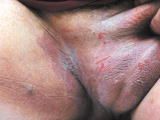- Clinical Technology
- Adult Immunization
- Hepatology
- Pediatric Immunization
- Screening
- Psychiatry
- Allergy
- Women's Health
- Cardiology
- Pediatrics
- Dermatology
- Endocrinology
- Pain Management
- Gastroenterology
- Infectious Disease
- Obesity Medicine
- Rheumatology
- Nephrology
- Neurology
- Pulmonology
Man With a Persistent Inguinal Rash
A 51-year-old man presents with a painful inguinal rash that has persisted for 3 months despite application of a combination corticosteroid and antifungal cream. The rash is associated with a strong odor.

A 51-year-old man presents with a painful inguinal rash that has persisted for 3 months despite application of a combination corticosteroid and antifungal cream. The rash is associated with a strong odor.
The patient's history includes hypertension, dilated cardiomyopathy as a result of alcohol abuse, and hyperlipidemia. He does not have diabetes mellitus.
The patient appears anxious but is otherwise alert and oriented. He is overweight. Vital signs and cardiac, pulmonary, and abdominal findings are normal.

He is circumcised and has normal genitalia; the testicles are of normal size and nontender. Moist, reddish brown patches, with irregular borders that extend to the skin fold edges, are noted on the bilateral inguinal skin folds and scrotum. Maceration of the skin is also evident in these areas (Figure 1).
A complete blood cell count reveals no leukocytosis; electrolyte levels are normal. Results of a potassium hydroxide (KOH) preparation of skin scrapings show no fungal forms. Wood's light examination of the inguinal rash reveals coral-red fluorescence, which is consistent with the diagnosis of erythrasma (Figure 2).
A course of oral erythromycin, 250 mg qid for 14 days, is prescribed. The rash resolves within a month. The patient is counseled on preventive measures.
ERYTHRASMA: A COMMONLY MISSED DIAGNOSIS
Superficial infection of the stratum corneum with the Gram-positive rod Corynebacterium minutissimum leads to the cutaneous eruption known as erythrasma. The eruption commonly occurs in occluded, moist skin folds, such as the axillae; inframammary regions; toe interspaces; and skin folds in the abdominal, intergluteal, and groin regions.1,2 Intertrigo refers to a nonspecific inflammatory process that occurs in these regions when the stratum corneum becomes eroded.3
Erythrasma is common in adults with diabetes.4 However, colonization with C minutissimum appears to be a frequent phenomenon in the general population; it was documented in more than 50% of Danish military recruits in one study.5
In addition to diabetes, other predisposing factors are obesity, poor hygiene, maceration of tissues, and a warm and humid climate.1,2,4 Skin lesions appear as reddish brown macules or patches with sharp margins, which may have associated scaling and inflammatory hyperpigmentation.1,6 Patients may complain of burning and pruritus in affected areas. The differential diagnosis of erythrasma includes candidiasis, psoriasis, dermatophytosis, seborrheic dermatitis, and acanthosis nigricans.1 It is plausible that erythrasma may coexist with other intertriginous infections.
MAKING THE DIAGNOSIS
Often, the diagnosis of erythrasma is not considered until after a trial of antifungal therapy has failed.7 A Wood's light examination can be used to diagnose erythrasma; the characteristic coral-red fluorescence of C minutissimum results from coproporphyrin III produced by the organism. The Wood's lamp has a glass filter that only allows long-wave ultraviolet light greater than 365 nm to pass through. Thus, for best results, examine patients in a windowless, dark room.
The Wood's lamp can also reveal fluorescence of Microsporum and Trichophyton species. These dermatophytes may appear blue-green and dull white, respectively. Tinea versicolor caused by Malassezia furfur may have variable fluorescence. Results of a KOH preparation of the organism show characteristic fungal forms, with a "spaghetti and meatball" appearance caused by hyphae and budding yeast.6,8
Direct microscopy can detect C minutissimum. Gram staining may demonstrate Gram-positive filamentous rods, which support the diagnosis. Cultures of the affected regions may also be performed when the diagnosis remains in question or to rule out other bacterial infections.1
TREATMENT
Antibacterial therapy may be topical or systemic. Topical or oral erythromycin or oral tetracycline is commonly prescribed. Other options include topical acne medication, such as clindamycin, and the antibacterial soap chlorhexidine.
Encourage patients to implement the following preventive measures to reduce occlusion of skin in affected regions1,2:
- Wear loose-fitting clothing.
- Maintain appropriate hygiene.
- Apply powder to keep affected regions dry.
References:
REFERENCES:
1.
Fitzpatrick TB, Johnson RA, Wolff K, et al. Infections involving the skin.
Color Atlas and Synopsis of Clinical Dermatology.
New York: McGraw-Hill; 2001: 580-584.
2.
Holdiness MR. Management of cutaneous ery-thrasma.
Drugs.
2002;62:1131-1141.
3.
O'Dell ML. Skin and wound infections: an overview.
Am Fam Physician.
1998;57:2424-2432.
4.
Montes LF, Dobson H, Dodge BG, Knowles WR. Erythrasma and diabetes mellitus.
Arch Dermatol.
1969;99:674-680.
5.
Svejgaard E, Christophersen J, Jelsdorf HM. Tinea pedis and erythrasma in Danish recruits. Clinical signs, prevalence, incidence, and correlation to atopy.
J Am Acad Dermatol.
1986;14:993-999.
6.
Fragola LA Jr, Watson PE. Common groin eruptions: diagnosis and treatment.
Postgrad Med.
1981; 69:159-63, 166-169, 172.
7.
Sindhuphak W, MacDonald E, Smith EB. Erythrasma. Overlooked or misdiagnosed?
Int J Dermatol.
1985;24:95-96.
8.
Krull EA, Babel DE. Diagnostic procedures of the skin. Part one: Wood's light, KOH slide, Gram's stain, and cultures.
J Fam Pract.
1976;3:309-312.
